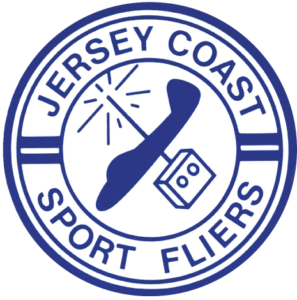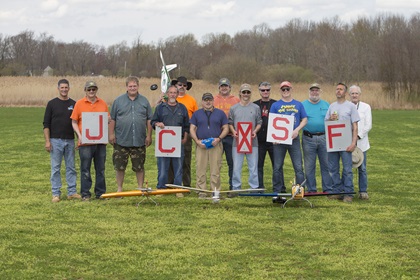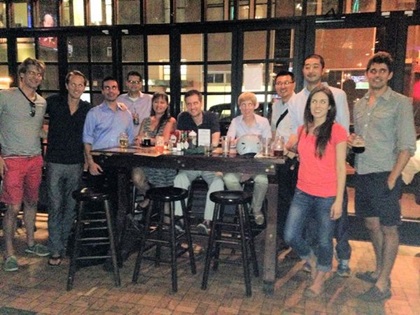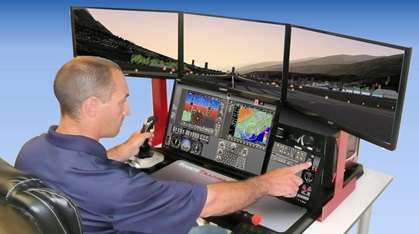As we take a look at non-traditional flying clubs in this issue, we’ll feature two types of clubs that are unique in the way they approach aviation.
Stan Berger served as president of the Jersey Coast Sport Fliers RC Model Club for many years, and is still active in club leadership. He took the time to share his experience with the club, and it sounds remarkably similar to the clubs we normally feature. The only difference is he never leaves the ground when his plane takes flight.

Another club that doesn’t require slipping the surly bonds of earth when members go fly is the Manhattan Flight Club. It operates a FlyThisSim TouchTrainer simulator and that’s it. There’s no need to worry about weather or fluctuating fuel costs or unexpected maintenance issues like a flat tire. In talking with club founder Taylor Jobe we learned the structure might differ a bit from a club with a Cherokee or 172, but the core elements and keys to success are exactly the same.
The common bond shared among all flying clubs – no matter what the member is flying – is a love of aviation, a supportive environment in which members can grow and learn, and the camaraderie a club offers its members.
Flying from the Ground: RC Model Clubs
A close parallel to traditional manned flying clubs can be found in RC clubs, The Academy of Model Aeronautics (AMA) is the largest model aviation organization in the world. Like AOPA, it is a strong organization that represents anyone who flies a model airplane or helicopter, small UAS, or other type of model aircraft.One example of a successful RC club is the Jersey Coast Sport Fliers based in Colts Neck, New Jersey. Founded in 1973, the club has been operating from a dedicated flying site at Dorbrook Park, which is a part of the Monmouth County Park System, since 1987. The club has more than 100 members who are actively building, flying, and participating in the club. Recently, the club has been making an effort to attract younger members by inviting Boy Scout and Girl Scout troops out to learn about RC models.
 To join the club, you must be a member of the AMA, which costs $75 annually. This is typical of many RC clubs, which often require an AMA membership.
To join the club, you must be a member of the AMA, which costs $75 annually. This is typical of many RC clubs, which often require an AMA membership.The Jersey Coast Sport Fliers have a well-designed website with membership information, as well as the club’s bylaws and events. Before a pilot may fly at Dorbrook Park, they must be checked out by a club instructor, much like a private pilot getting checked out to fly a club airplane.

In modeling there is something called a buddy cord that connects two controllers so the pilot and instructor both have their own controls. If the instructor needs to take control of the aircraft, they can flip a switch to transfer control to their controller.
The club meets monthly to discuss club business and holds about a dozen events throughout the year to build camaraderie, have a little competition and fun. The AMA also requires clubs to hold an annual safety seminar.
There are many benefits to becoming a member. One of the most important is gaining access to flight instruction. Jersey Coast Sport Fliers has instructors who volunteer their time, so instruction is free to members. In addition, members provide mentorship on a host of topics, including what type of model to buy for the type of flying you want to do and assistance in building a model and inspecting it before the first flight. And, like traditional flying clubs, more experienced pilots often mentor newer pilots.
One of the other benefits is being part of a community. “We wanted the community to know who we are,” Stan said. “We take part in the Adopt-a-Road program where we clean up the roadside. I started that 20 years ago and we still do it today.” Twice a year the club picks up litter on a two-mile stretch of road right in front of the park, and there are signs that say the road is maintained by the Jersey Coast Sport Fliers. “We made sure we would get maximum exposure and recognition from the very people that we consider our landlords.”

In addition, the club offers programs to the public that teach kids how to build and fly model airplanes. They have worked with the Boy Scouts and Girl Scouts, hosted public air shows, and even hosted a fundraiser to purchase a defibrillator to put at the field.
Being a part of the larger community is one of the key aspects of the club. “Things like that are very important. Like general aviation airports, once they’re gone, they’re gone,” Stan said.
Urban Aviators: A Simulator Club in the City
Living in a big city, particularly Manhattan, it may be a challenge to get to a GA airport to fly, especially if you don’t have a car. When Taylor Jobe moved to New York City and based his Cessna 210 at Westchester County Airport (HPN), he quickly learned that lesson.
The airport is about a 45-minute to hour drive north of the city on a good day, and longer by train. Getting to airports in New Jersey or Long Island can be equally challenging, and many of the airports are crowded with commercial or corporate traffic. That means you’re spending more time on the ground waiting to takeoff, reducing the number of takeoffs and landings you can do in an hour.
Taylor wondered, “How do I engage in aviation when I can’t fly? That was really the question.” The idea for a simulator-based club came after he took the train to Westchester to put some time in on a Redbird simulator with an instructor.
On the way home he thought, “Why did I just spend $400 and five hours of my life to do something that I can do here in the city? That got me thinking,” Taylor said. “What would it take to put a simulator in the city?”
He realized he didn’t know any other pilots in the city, so he formed the Manhattan Flight Club Meetup group in 2014. Meetup is an online platform for creating groups and connecting people with similar interests.

Taylor realized “a huge part of aviation is talking to other pilots. We just started getting together at a bar once a month and we’d have some topic like GPS apps or some loose kernel.” The community grew and about six months to a year later there was enough interest in getting a simulator.
Taylor decided to rent a space, buy a simulator, put together a web site and see if they could make the idea work. “I gave it six months because that’s what the lease was on the office,” Taylor said. “It’s got to pay for itself in that time. And it did very quickly.”
The space is located at 29th Street and Madison Avenue in downtown Manhattan. There is space for the simulator and a conference where the monthly pilot roundtables are held. It provides the perfect location for members to stop by on their way home from work. The most popular time to use the simulator is between 5 pm and 8 pm weeknights. This year members have been logging between 40 and 70 hours a month, although there have been some months in past years with more than 100 hours logged.
The club chose to get a FlyThisSim TouchTrainer (see the February 2019 Club Connector for a roundup of simulators including the TouchTrainer). One of the advantages of this simulator is it can profile a variety of aircraft cockpits, appealing to a broad audience flying a diverse fleet. In addition it is an FAA-approved Basic Aviation Training Device (BATD), meaning pilots training for their instrument rating may log up to 10 hours toward the requirements.

More importantly to Taylor, “you can maintain your instrument currency, which is a big deal. But now you can do it without an instructor,” he said. “You can do it on your own. People can come in, get their six approaches on their own and do not have to waste a weekend [going out of the city to an airport].”
The club has more than 600 members in the Meetup Group, but it’s hard to say how many are active. Membership is flexible to suit whatever level of participation people want to engage in, Taylor said.
There are three types of memberships – Social, which is free and you may attend the monthly roundtable discussions and can book the simulator for $40 an hour. A standard membership is $15 a month and members pay $32 an hour for the simulator, which is a 20 percent discount. An Unlimited membership is $120 a month, with a three-month minimum. Unlimited members can use the sim as much as they want with access 24 hours a day, seven days a week. The club uses a program called Bookeo as its online scheduler.
Members use varies from those who come in just for currency every three to six months to those who fly multiple times a week. For Taylor, “The question is not whether this replaces time in the airplane, it’s about making your time in the airplane more valuable. That’s the role of the simulator.”
Taylor’s motivation “is really to get more people flying more often.” The monthly pilot roundtables provide the opportunity to build camaraderie with other pilots as well as to learn from each other. In the sim, the club holds “Flight Nights” where four people use the sim at the same time. One pilot flies a scenario with the other pilots observing. “You learn a lot by watching someone else fly,” Taylor said. Sometimes you learn more by watching.”
The beauty of the Manhattan Flight Club is its simplicity, low cost and ease of access. There is no board, and there are virtually no operating costs other than the cost of acquiring a simulator and office rent.
It’s a model that is easy to duplicate. Start by building a community. “It’s the most important thing. Building a community is key, it’s critical,” Taylor said. “And then provide education, that was the next pillar.” Whether it’s through roundtable events or in the simulator, it’s about sharing information, learning about flying. And the last piece is access -- making it easier for people to access aviation.
The Manhattan Flight Club has a simple philosophy, which can be found on its web site:
Flying is awesome. This is a group for everyone who believes that General Aviation creates better people, stronger communities, and a happier world.
We are building a home for General Aviation in Manhattan by connecting the GA community through social events, hosting expert-led educational learning sessions, and providing access to flight simulators through our Sim Lab, all right here in Manhattan.